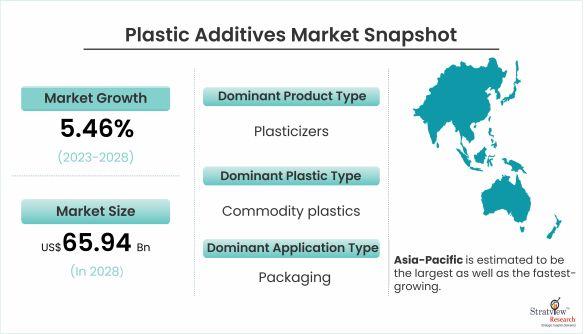Introduction
The plastic additives market plays a crucial role in enhancing the performance, durability, and sustainability of plastic materials across various industries. As the demand for advanced polymers and plastics continues to rise, the market for plastic additives has witnessed significant growth and innovation. This article explores the key trends, drivers, challenges, and innovations shaping the plastic additives industry.
The plastic additives market is estimated to grow from USD 47.76 billion in 2022 to USD 65.94 billion by 2028 at a CAGR of 5.46% during the forecast period.
Read more: https://www.stratviewresearch.com/1318/plastic-additives-market.html
Understanding Plastic Additives
Plastic additives are chemical compounds or substances added to plastics during their processing or formulation to achieve specific performance-enhancing properties. These additives can improve characteristics such as strength, flexibility, UV resistance, flame retardancy, and color stability, among others. Plastic additives are widely used in industries such as automotive, packaging, construction, and electronics to meet the ever-increasing demands for high-performance plastics.
Key Drivers of the Plastic Additives Market
Growing Demand for Lightweight and Fuel-Efficient Vehicles: The automotive industry's emphasis on lightweight materials to improve fuel efficiency and reduce emissions has led to increased use of advanced plastics, driving the demand for additives that enhance properties like strength and heat resistance.
Sustainable Packaging Solutions: The push for sustainable and eco-friendly packaging materials has spurred innovation in biodegradable and recyclable plastics, with additives playing a critical role in ensuring these materials meet performance standards.
Rising Construction Activities: The construction industry utilizes plastic materials with additives to improve durability, weather resistance, and energy efficiency, contributing to the growth of the market.
Technological Advancements: Ongoing research and development efforts have led to the creation of novel plastic additives, including nanocomposites and smart additives, which offer advanced functionalities and improved performance.
Challenges Faced by the Industry
While the plastic additives market is expanding, it also faces several challenges:
Environmental Concerns: Some plastic additives, such as certain flame retardants, have raised environmental and health concerns, prompting regulatory scrutiny and driving the need for more eco-friendly alternatives.
Regulatory Changes: Evolving regulations related to chemical usage in plastics can impact the industry's product formulations and require investments in research and development for compliance.
Volatility in Raw Material Prices: The prices of raw materials for plastic additives can be volatile, affecting production costs and product pricing.
Innovations in Plastic Additives
In response to these challenges and market demands, the plastic additives industry is experiencing a wave of innovation:
Bio-Based Additives: Manufacturers are developing bio-based additives derived from renewable sources, reducing the environmental footprint of plastic materials.
Smart Additives: Additives with functionalities like self-healing, antimicrobial properties, and UV sensing are being integrated into plastics, expanding their potential applications.
Nanotechnology: Nanocomposites are gaining popularity for their ability to enhance mechanical properties, thermal stability, and barrier properties of plastics.
Recycling-Compatible Additives: Additives that facilitate recycling and improve the properties of recycled plastics are being developed to promote a circular economy.
Conclusion
The plastic additives market is dynamic and evolving, driven by the need for high-performance plastics and sustainable solutions across various industries. Innovations in materials and additives are crucial for meeting these demands while addressing environmental concerns. As the industry continues to navigate challenges and regulations, collaboration among manufacturers, researchers, and regulators will be essential in shaping a sustainable and prosperous future for the plastic additives market.
